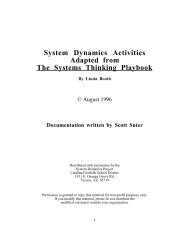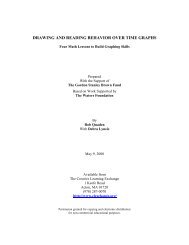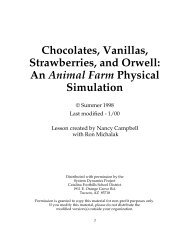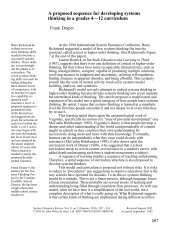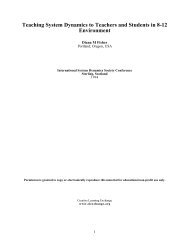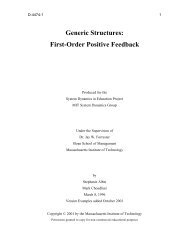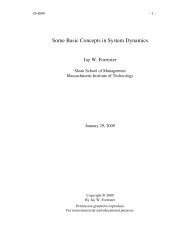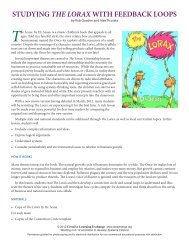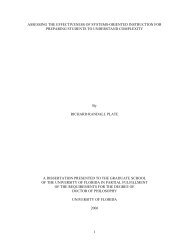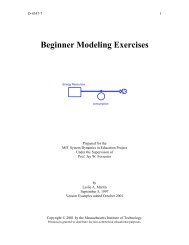Keystone Species in an Ecosystem Using Connection Circles to Tell ...
Keystone Species in an Ecosystem Using Connection Circles to Tell ...
Keystone Species in an Ecosystem Using Connection Circles to Tell ...
You also want an ePaper? Increase the reach of your titles
YUMPU automatically turns print PDFs into web optimized ePapers that Google loves.
Fur traders hunted sea otters <strong>to</strong> the br<strong>in</strong>k of ext<strong>in</strong>ction. The decl<strong>in</strong>e of the sea otterpopulation allowed sea urch<strong>in</strong>s <strong>to</strong> proliferate, <strong>an</strong>d the urch<strong>in</strong>s devastated the kelp forests.When kelp forests decrease, m<strong>an</strong>y mar<strong>in</strong>e <strong>an</strong>imal species are deprived of habitat <strong>an</strong>dtheir numbers decl<strong>in</strong>e as well. Without hunters, sea otters could thrive around AmchitkaIsl<strong>an</strong>d.? Author Sus<strong>an</strong> Qu<strong>in</strong>l<strong>an</strong> calls the sea otter a “keys<strong>to</strong>ne species.” What does she me<strong>an</strong>?When the sea otter was removed from the Aleuti<strong>an</strong> Isl<strong>an</strong>ds, the ecosystem collapsed <strong>an</strong>dbecame barren of m<strong>an</strong>y species. Similarly, if the keys<strong>to</strong>ne <strong>in</strong> <strong>an</strong> arch is removed, all theother s<strong>to</strong>nes will fall. Any species that is disproportionately import<strong>an</strong>t (i.e., compared <strong>to</strong>its population) <strong>in</strong> the ma<strong>in</strong>ten<strong>an</strong>ce <strong>an</strong>d bal<strong>an</strong>ce of <strong>an</strong> ecosystem, <strong>an</strong>d whose removaldisrupts or destroys the food web, is thought <strong>to</strong> be a keys<strong>to</strong>ne species. Some scientistsbelieve that only preda<strong>to</strong>rs c<strong>an</strong> be keys<strong>to</strong>ne species but others disagree.? What are the keys<strong>to</strong>ne species <strong>in</strong> ecosystems where we live?Among <strong>an</strong>imals generally considered <strong>to</strong> be keys<strong>to</strong>ne species are prairie dogs, beavers,freshwater bass, gray wolves, <strong>an</strong>d salmon.? Where c<strong>an</strong> we learn more about how the feedback structure of the Tw<strong>in</strong> Isl<strong>an</strong>dsecosystem caused the problem we observed?For more <strong>in</strong>formation on this lesson <strong>an</strong>d its next steps, see Lesson 11 <strong>in</strong> our next book,The Shape of Ch<strong>an</strong>ge, S<strong>to</strong>cks <strong>an</strong>d Flows, also available from the Creative Learn<strong>in</strong>gExch<strong>an</strong>ge at www.clexch<strong>an</strong>ge.org.Additional Background InformationStudents often generate m<strong>an</strong>y good questions that go beyond the orig<strong>in</strong>al s<strong>to</strong>ry. Here is somemore background <strong>in</strong>formation that might be helpful.? Why had sea otters come back <strong>to</strong> Amchitka but not Shemya?The s<strong>to</strong>ry only tells us that a few otters had escaped hunters but “they had not returnedyet <strong>to</strong> Shemya Isl<strong>an</strong>d.” Researchers have proposed several theories <strong>to</strong> expla<strong>in</strong> theabund<strong>an</strong>ce of sea otters on some isl<strong>an</strong>ds <strong>an</strong>d their scarcity on others. Among the causeshypothesized are coastal currents, algae production, complex fac<strong>to</strong>rs affect<strong>in</strong>g otter prey,predation on otter pups, <strong>an</strong>d environmental contam<strong>in</strong>ation. Interested students c<strong>an</strong>pursue this s<strong>to</strong>ry further.? In the absence of sea urch<strong>in</strong>s, do sea otters eat so much of <strong>an</strong>other species that it becomesdepleted?Sea otters c<strong>an</strong> deplete their food sources rapidly. As is the case with other species,feedback loops <strong>in</strong> the environment operate <strong>to</strong> reduce otter populations when food isscarce <strong>an</strong>d allow it <strong>to</strong> <strong>in</strong>crease when prey is abund<strong>an</strong>t.13



